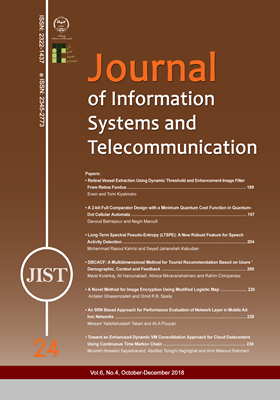-
-
List of Articles
-
Open Access Article
1 - Retinal Vessel Extraction Using Dynamic Threshold And Enhancement Image Filter From Retina Fundus
erwin erwin Tomi Kiyatmoko -
Open Access Article
2 - A 2-bit Full Comparator Design with Minimum Quantum Cost Function in Quantum-Dot Cellular Automata
Davoud Bahrepour Negin Maroufi -
Open Access Article
3 - Long-Term Spectral Pseudo-Entropy (LTSPE): A New Robust Feature for Speech Activity Detection
Mohammad Rasoul kahrizi Seyed jahanshah kabudian -
Open Access Article
4 - DBCACF: A Multidimensional Method for Tourist Recommendation Based on Users’ Demographic, Context and Feedback
Maral Kolahkaj Ali Harounabadi Alireza Nikravan shalmani Rahim Chinipardaz -
Open Access Article
5 - A Novel Method for Image Encryption Using Modified Logistic Map
ardalan Ghasemzadeh Omid R.B. Speily -
Open Access Article
6 - An SRN Based Approach for Performance Evaluation of Network Layer in Mobile Ad hoc Networks
meisam Yadollahzadeh tabari Ali A Pouyan -
Open Access Article
7 - Toward an Enhanced Dynamic VM Consolidation Approach for Cloud Datacenters Using Continuous Time Markov Chain
Monireh Hosseini Sayadnavard Abolfazl Toroghi Haghighat
-
The rights to this website are owned by the Raimag Press Management System.
Copyright © 2017-2025







